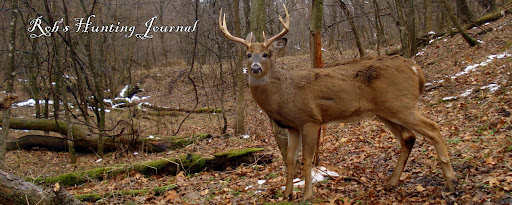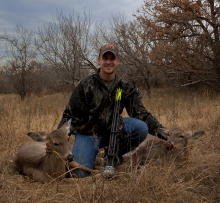My fascination with trail cameras started about 5 years ago when I was a Park Ranger. A coworker of mine had a trail camera that we would use in the wildlife management areas at the lake I worked at. The pictures we got from that camera amazed me and revealed what was hiding in the woods that the majority of people never saw.
I decided to get my own camera, so I bought the cheapest digital one on the market at the time - a Wildview model that had less than 1 megapixel resolution. I put the camera up on the property I hunt and got a few deer pictures, but I was really disgusted with the performance of the camera. It seemed to have a mind of its own. It would take random pictures of nothing, the flash was terrible in the nightime pictures, it went through batteries like crazy, and the low resolution made the pictures really grainy.
I decided to upgrade and get a Cuddeback Excite camera. It wasn't cheap, but it definitely outperformed my first camera. In fact, it has taken thousands of pictures, some of which are really good. This camera is a 2.0 megapixel and I still use it today, although lately it has been acting up a little. It also eats up batteries pretty quickly.
Last year I bought another Cuddeback camera - this time the Capture IR model. This is an infrared camera that does not use a flash for nightime pictures. The idea behind using IR is to not spook game and to keep the camera hidden better from possible thieves. This camera has done pretty good when it comes to battery life. The resolution of this camera is 5.0 megapixels for daytime shots and 1.3 megapixel black and white images for nightime shots. I have been really impressed with the daytime pictures this camera takes, but the nightime pictures are absolutely terrible. I have yet to get a good one.
Recently, after getting fed up with store-bought cameras, I started researching what it would take to build my own homemade trail camera unit using a standard digital camera. After reading lots of articles, forums, and do-it-yourself tutorials on the internet I decided to give it a try. There are several websites and entire forums dedicated to this topic, which is commonly referred to as a "Homebrew Trail Camera". I found a cheap Sony camera on craigslist and I ordered a pre-drilled kit from a company called Whitetail Supply. The kit arrived in the mail a few days ago and I couldn't wait to get started. Here is what I started with. (I've actually already glued a few of the lenses in place inside the case when I took this picture.)

I had to take the Sony camera apart and actually solder some connections inside the camera. I thought this was the hardest part of the whole project because I have never dealt with working on electronics before. I routed the wires through a hole I drilled in the case of the camera and attached a quick-connect so the camera could be easily attached to the sensor control board. I finished putting everything in place and this is what it looked like.

Here it is closed up and ready to be given a test run.

Here is a sample picture from earlier this evening. I gave the camera a quick test while visiting out in the yard with my family.

The neat thing about this camera is that I can still use the Sony digital camera independently from the control board by using the quick-connect to disconnect it from the unit. It also has a pipe-through security feature that allows you to run a lockable cable through the camera to attach it to a tree. It is 4.1 megapixels so the resolution of the pictures should be fairly decent. The control board and sensor run on one 9-volt battery while the camera itself is powered by two AA batteries. The company that sold me the kit claims the 9-volt will last a year. The real test will be to see how long the AA batteries will last.
I can't wait to get this unit out in the woods to see how it performs. It was so easy to build that I have already started getting components to build a second one. Stay tuned and hopefully I will have some real trail camera shots to post from this camera in the next few weeks.

































